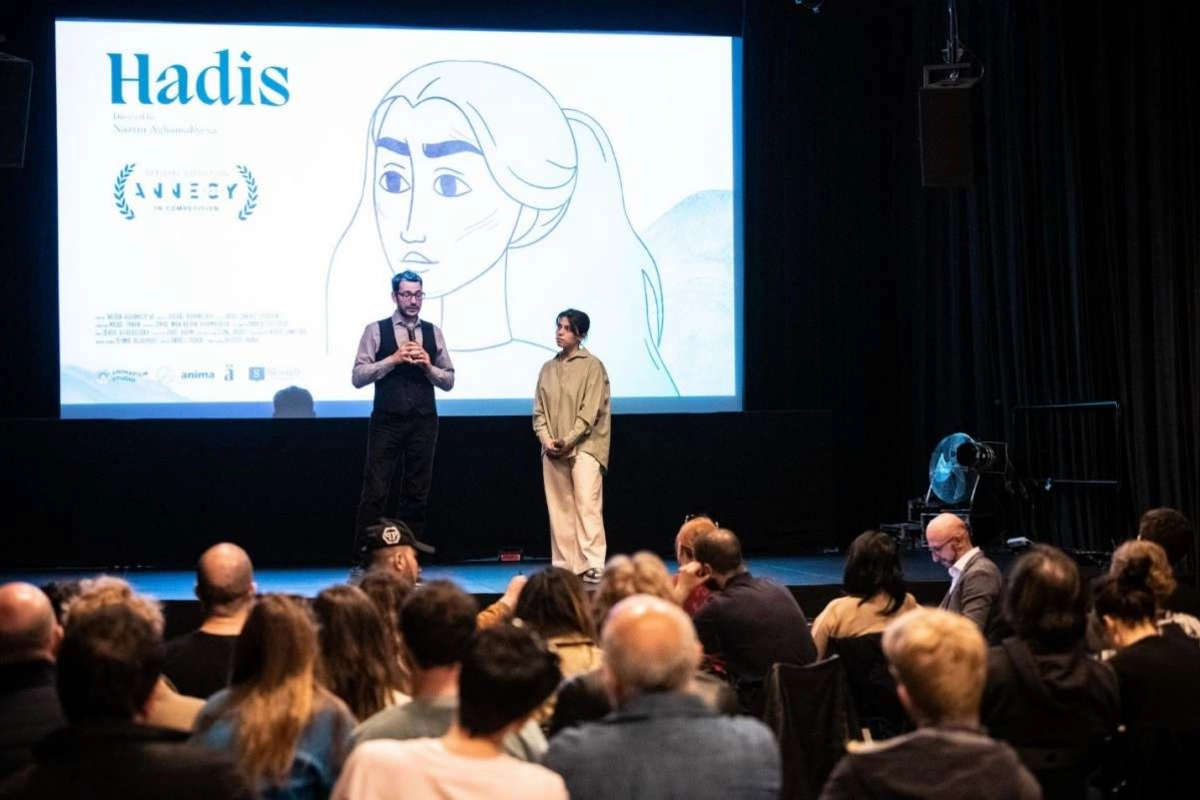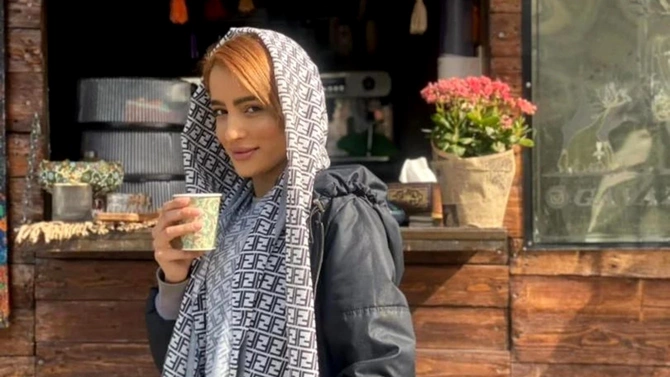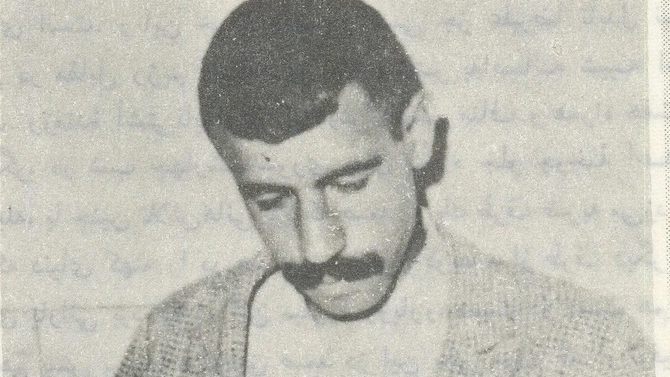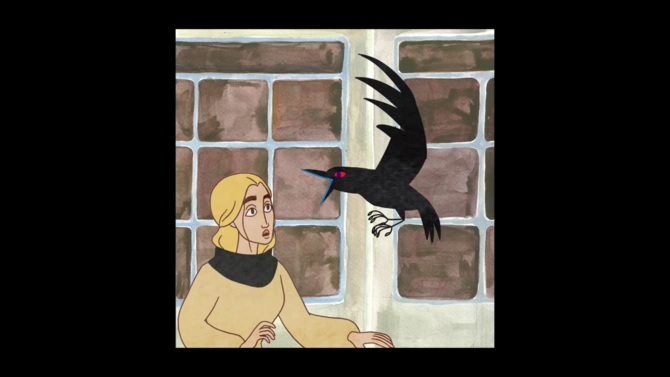
An Azerbaijani production, Hadis, was chosen from over 3200 others to be shown at the Annecy Festival. The animation is a homage to Hadis Najafi, who was shot dead during the 2022 protests in Iran.
Image: Animafilm Studio/FB
A movingly thought-provoking Azerbaijani production called Hadis is amongst the 71 short-format movies that will be shown this June at the 2023 Annecy International Animation Film Festival. It has been selected from over 3200 contenders and classed as one of 19 in the “Perspectives” category. Hadis is a highly stylised homage to Hadis Najafi. The real life Hadis was a 22-year-old ethnic Azerbaijani Turk from Iran who was shot dead by security forces on September 21, 2022 while attending protests against the earlier killing in custody of Mahsa Amini. Mahsa herself had been arrested following a tightening of the rules in the Islamic Republic that require women to ‘properly’ cover their hair according to Tehran’s interpretation of Muslim law.
In the film, the fictional Hadis character ends up in a precarious situation due to having allowed her hair to briefly become publicly visible. Behind the visually captivating surface, a general European audience is therefore likely to see the signalled message of women’s oppression in Iran. However, they might miss the important additional layer that widens this to one of diminished minority rights in general – and of Iran’s side-lining of Azerbaijani Turks in particular. The most conspicuous reference to this is that the film’s Hadis is an Azerbaijani Turk woman living in Miyana (the Azerbaijani-Turkish name for Mianeh[1]) where she says that “I am not myself” in a “country full of prohibitions [where] everything from my femininity to my mother tongue is forbidden.”[2]

Image: Hadis Najafi
Azerbaijanis are likely to find several other more subtle resonances[3]. The swirling crows which create such an atmosphere at the start of the piece are likely to remind local viewers of Ulduz və Qarğalar (Ulduz and the Crows) – an allegorical fairy tale by the Azerbaijani-Iranian writer Samad Behrangi. Indeed, it’s soon apparent that the Hadis of the movie keeps a copy of that very book on her vanity table. In the Behrangi story, the heroine Ulduz is a child who feels trapped by circumstances until much-maligned crows come to her aid. ‘Mother Crow’ is a misunderstood but kindly figure who ends up being beaten to death by Ulduz’ authoritarian step-mother, her last words being “Don’t we have a right to live, too? Why can’t we be friends with whomever we want?”
In the 1960s, Behrangi had been arguing for the right to be oneself at a time when some perceived the Shah’s regime to be assimilating cultures and westernising Iran at an excessive rate. ‘Crows’ could be read as a metaphor[4] for the black hijab (head-cover) of pious Muslim women, a choice for which Ulduz in Behrangi’s book could be seen to be subtly supporting.

Samad Behrangi Image: public domain
In Hadis, the crows are on the ‘other side’. Now they are part of the system that stifles. In the post-1979 Islamic republic the ‘crow’ of hijab has become something that many women feel forced to wear rather than being simply a symbol of piety. Whereas the crows were depicted positively in Behrangi's tale, this story shows that what was once viewed positively can grow to become a symbol of oppression. According to the Azerbaijani Cultural Society of Northern California (ACSNC), the driving force behind the film, this reading misses a more important point:
“Hadis departs from Ulduz and The Crows by changing the symbology of the crows themselves… In Hadis, the crows are what robs her of her ability to express her Azerbaijani identity authentically and publicly, stifling her very existence and eventually taking it from her.”

Image: courtesy photo
The ACSNC is keen to stress that “we are highlighting ethnic rights here and not [at least not most importantly] women’s rights” adding that “Samad [Behrangi] did not … die for average Iranians, he died for average Azerbaijanis.”
This reference to Behrangi’s death might appear to be a clue to the symbolism of the ruined mediaeval bridge on which the film’s action culminates. A classic such bridge exists at Khudaferrin near which Behrangi drowned in 1968, a death that is widely considered to have been suspicious - probably orchestrated by the Shah’s secret service. What’s more, the Khudaferrin Bridge is highly symbolic as a location, having been a major artery for communication between northern and southern parts of the Azerbaijani regions up until the 19th-century division that resulted from Russia’s annexation of the north. However, as the film-makers point out, the culturally Azerbaijani regions have several other historical bridges and the location in the film actually represents the Qız Körpüsü (Maiden Bridge) near Miyana/Mianeh. That makes sense, not just because it would be far closer to Hadis’ family home than Khudaferrin, but also for giving an even more pointed political message. After all, the reason that Qız Körpüsü is in such a ruinous state today is because the bridge’s central arch was blown up in December 1946 by forces loyal to the Azerbaijan Democratic Party who briefly led the Azerbaijan People’s Government (AMH). From the Iranian point of view these folks were “communist separatists” and the AMH was an illegal Soviet puppet state. Many Azerbaijani Turks strenuously disagree with such characterisations, seeing the AMH as a brief window of freedom and independence for their people in the Azerbaijani lands that are now once again within Iran. As the film’s sponsors put it, the “[Miyana] bridge was blown up to stop Iran’s Shah’s military when they were coming to Azerbaijan during the 1 year of democratic independence in South Azerbaijan” going on to “commit a brutal massacre killing thousands in one night.”
The film is stylistically impressive while the artistic approach makes appealing use of watercolours for the animation. The film’s soundtrack underlines its national credentials by including The Path of Thunder by much respected Azerbaijani composer Gara Garayev and performed by Sevda Alekbarzadeh, a singer hailing from a family of prominent writers. The narrator’s semi-whispered delivery conjures up very much the style of Azerbaijani spiritual poetry recitation and includes quotes from Gözlər, nə gözlər? (Eyes, what eyes?) by Seyid Abulgasim Nabati (1812-1873), an Azerbaijani-Turk poet from Ushtebin, once one of the prettiest ‘stacked villages’ on the Iran side of the Araz Valley.
The film’s director, Baku-born Nazrin Aghamaliyeva is the co-founder of the Azerbaijan Animation Association. Her work on Hadis was facilitated by a scholarship from ACSNC (mentioned above) who are keen to point out that the project has an added symbolic value in demonstrating how well Azerbaijanis from very different backgrounds can work together despite long periods of historical separation.
Nazrin’s husband, the film’s producer, Rashid Aghamaliyev, is the founder of Animafilm Studio and also Animafilm Festival – Baku’s own annual international animation event. Back when that had been newly founded in 2018, Rashid was amongst the first group of Azerbaijanis to be represented at Annecy. We wish him, Nazrin and the whole team every success on their return to France this June – now as exciting new film makers in their own right.

[1] The real-life Hadis Najafi was born in Karaj, a satellite city west of Tehran, but her parents were from Mianeh/Miyana.
[2] Language rights for minoritised people in Iran (especially the lack of native language schooling) continue to be significant political issues as we have discussed previously on the Caspian Post and

[3] Quite intentionally: the film is sponsored by the Azerbaijani Cultural Society of Northern California.
[4] References to the hijab as making women crow-like go right back to the hadiths (scholarly religious commentaries on the Koran).
Share on social media